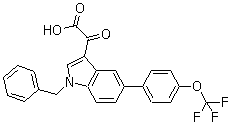
Cat No:LP000159
Product Name:Tiplaxtinin;PAI-039;Tiplasinin
CAS No:393105-53-8
Purity: ≥99%
Solubility: In DMSO
Storage: -10°C
Tiplaxtinin (PAI-039), a small-molecule inhibitor of PAI-1 activity, on the urothelial cell lines. A significant inhibition in cellular proliferation is noted in T24 cells treated with Tiplaxtinin with the documentation of a favorable IC50 value of 43.7±6.3 μM and in UM-UC-14 cells 52.8±1.6 μM whereas the benign cell line, UROtsa, is noted to have a higher IC50 value of 70.3±0.1 μM. Notably, IC50 values of Tiplaxtinin in detached cells, 19.7±3.8 μM in T24, 44.5±6.5 μM in UM-UC-14, and 31.6±6.1 μM in UROtsa, are significantly lower than the IC50 values calculated for cells cultured in the presence of Tiplaxtinin under attached conditions[2].
In the vena cava protocol, Tiplaxtinin (PAI-039) pretreatment significantly reduces thrombus weight at Tiplaxtinin doses of 3, 10 and 30 mg/kg. When Tiplaxtinin is dosed in a treatment paradigm 4 h after stable arterial and venous thrombosis, a significant reduction in thrombus weight is observed 24 h later at Tiplaxtinin doses of 3, 10 and 30 mg/kg[1]. Tiplaxtinin (PAI-039) is administered by oral gavage to athymic mice bearing human bladder cancer cell line T24 xenografts and human cervical cancer HeLa cell xenografts. The subcutaneous tumor growth of both T24 and HeLa cell xenografts treated with Tiplaxtinin is markedly reduced compared with untreated controls. Specifically, at the end of the study, control T24 xenografts are noted to be 1,150±302 mm3 compared with 593±328 mm3 for T24 xenograft tumors treated with 5 mg/kg Tiplaxtinin (P<0.0001) and 627±248 mm3 for T24 xenografts treated with 20 mg/kg (P<0.0001)[2]. Tiplaxtinin (1, 3, and 10 mg/kg) is subjected to electrolytic injury of the coronary artery. Tiplaxtinin (PAI-039) causes prolongation in time to coronary occlusion (control, 31.7±6.3 min; 3 mg/kg Tiplaxtinin, 66.0±6.4 min; 10 mg/kg, 56.7±7.4 min; n=5-6; p<0.05) and a reduced thrombus weight (control, 7.6±1.5 mg; 10 mg/kg Tiplaxtinin, 3.6±1.0 mg; p<0.05)[3].
